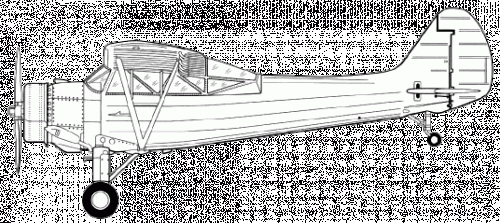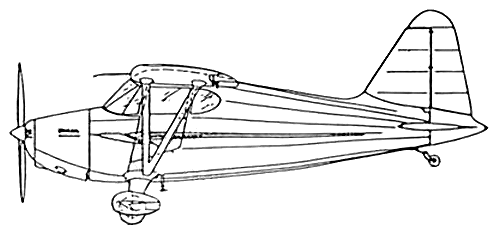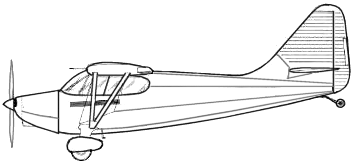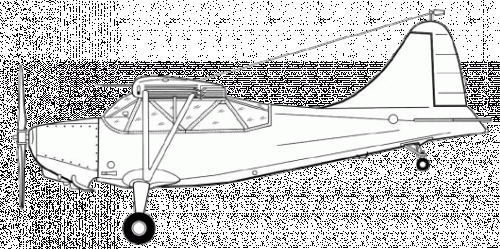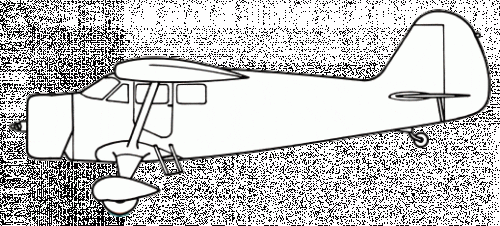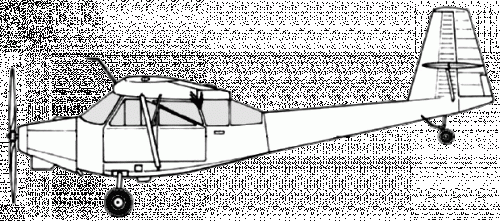- Joined
- 25 June 2009
- Messages
- 13,735
- Reaction score
- 2,913
Although we already have a Vultee topic in this section, which includes the post 1939 Stinson products, there isn't any dedicated topic for that company.
Later on in this page I will try and recapitulate all of this company's aircraft models since its inception, but for now, I would like to dwell a bit on what I have emphatically called "The great Stinson confusion." I'm not just talking about the complexity of the company's designations (after all they were not any more complex than most manufacturer's systems at the time), but rather of the confusion that has existed up to this day in most sources, even authorized ones, regarding the designations and redesignations of Stinson aircraft by Vultee, by Convair and by the military. What prompted me to share this with you today is the realization of my own mistakes, trying to identify where they may have come from, and realizing that the source goes a long, long way!
First of all, the designation system. To make it simple:
So when Vultee acquired the Stinson division of AVCO to form Vultee-Stinson, the company had four types to add to its list of models (a fifth one being a navigation trainer, which apparently should have been a Navy version of the Reliant).
In what seemed like a logical move, Vultee reserved five model numbers in their own list for these, adding the prefix V- to them: thus were born the V-74 to V-78 designations. That's where the first major source of confusion came: from the manufacturer itself. Indeed, several of these numbers were already in full use by another division of the company!
PROBLEM No. 1: THE VIGILANT AS V-74
While it apparently hadn't received a Stinson designation prior to the Vultee-Stinson merger, the Vigilant soon became known as the V-74. However, the Vultee Division had already allocated the designation Model 74 to the second production version of the Valiant trainer, known as BT-13A in the Army and SNV-1 in the Navy. How two identical numbers could have been allocated at the same time by two divisions without somebody noticing is anyone's guess... A decision was made to change the designation of the Vigilant, but the damage had been done, and documents using the two designations had already been circulated.
Up to this day, you will find numerous books and sites that call the Valiant the V-74, and just about as many that call the Vigilant just the same! And that's fair enough, considering they both had that designation for a while (though the V- prefix was seldom used before the merger).
PROBLEM No. 2: THE VIGILANT REDESIGNATED AS V-70
Redesignating the V-74 as V-70 must have seemed a smart decision at the time. But was it? The Model 70 designation had already been used for Vultee's own Army XP-54 proposal. The design, however, was evolving fast, and new iterations had appeared under the Models 78, 79, 84 slots. Someone must have decided that the #70 slot would no longer be in use, and reallocated that number to the Vigilant as V-70 (why they didn't use V-71, which doesn't seem to have applied to any existing model, is beyond me). So maybe it was a smart move to simplify matters on company documents, but having two separate Model 74 and Model 70 types has considerably complicated the work of historians when trying to untangle the mess of Vultee-Stinson designations!
PROBLEM No. 3: THE VOYAGER THAT WASN'T AND ITS DOUBLE DESIGNATORS
Numerous problems arise in fact when dealing with the Voyager, actually. First of all, as we've seen, the existence of double designators by Stinson for the same aircraft (HW-75, -85 and -90 being also called the Model 105, Model 10 and Model 10A). The two designations continue to be used indistinctly to this day, and very often people believe they refer to different types, which they don't. Also, in many people's minds, all of these aircraft are Voyagers, while in fact the name was only used from 1941 on, and therefore should never be used to designate the Model 105 (HW-75) of 1939 or the Model 10 (HW-80) of 1940.
PROBLEM No. 4: VULTEE'S AMBIGUOUS MODEL NUMBER FOR THE VOYAGER
Then comes Vultee, who think it smart to call it the V-75 (leading to the notion that this was the same as HW-75, while the designation applied to the entire series).
PROBLEM No. 5: MILITARY VOYAGERS
If you look at just about any online source on the Voyager, you will see the same assertion: that they were initially designated AT-19A and -19B, before changing to L-9A and L-9B. Of course this was NEVER the case. EVER. Six examples of the Model 10 (HW-80) were evaluated by the Army Air Forces in 1941 as the YO-54. A subsequent order for eight production examples of the Model 10A (HW-90) was placed and they were designated as L-9A, while another twelve aircraft were impressed from civilian examples as L-9B. Now please keep in mind that these allocations were done in 1942 [42-88666/88673], at at time when the Reliant had ALREADY been ordered as the AT-19 advanced trainer [42-46640/46889]. It would make absolutely NO sense to designate these small liaison types as Advanced Trainers, even less so to call them by the same designation already in use for another completely different aircraft of the same manufacturer! So you may ask, how come such a gross mistake has been repeated all over the webs? First of all because of people like me, who repeated in good faith for many years what they had read in authoritative books. Many reliable sources make exactly the same mistake, which makes you wonder: WHERE did they get the notion that the L-9 aircraft could have been called AT-19 at any point in time? I decided to check the mother of all aviation lists, or just about, the wonderful booklet published by Fahey in 1948 about every Army aircraft type since the beginning, and SURPRISE! That's where the mistake came from. Fahey being 99% right about about what he wrote (he omitted stuff that he didn't know or wasn't allowed to list), people like Bowers or whoever ever counted in U.S. aviation book writing probably never questioned what they found in this particular source, while in this case they should.
PROBLEM No. 6: CONVAIR'S AMBIGUOUS MODEL NUMBERS
Then comes Convair, who launch a new liaison type to be produced by the Stinson Division (the Army L-13) and call it their Model 105, less than five years after Stinson's original Model 105... while at the same time relaunching the Voyager in a new post-war commercial version... but calling it their Model 108!
PROBLEM No. 7: VOYAGER OR STATION WAGON?
You will find that most people use the name Station Wagon indistinctly for all post-war Voyagers. However, the postwar Model 108 was just the Voyager when it appeared. Subsequent production versions were the Models 108-1, 108-2, 108-3, and only the latter two had part of their production run marketed as Flying Station Wagon instead of Voyager because the interior had been optimized for more payload. Externally the regular Voyagers can't be told apart from the Station Wagons, except for the paint scheme, when it hasn't been changed. The fact that many users repaint their aircraft after their own fashion, sometimes even applying Station Wagon motifs to regular Voyagers, only adds to the confusion. 108-3 can be recognized from the older versions by its taller tail fin. The Model 108-4 was a sole example fitted experimentally with a 125hp engine, and then scrapped by Piper for parts; the Model 108-5 was an upgraded production version to be produced by Univair, but only one example was built.
PROBLEM No. 8: THE SENTINEL
Not much of a problem, actually. This brand new model developed by the Stinson Division for the Army Air Forces after the Vultee-Stinson merger was evolved from the Voyager but meant strictly as a military liaison type from the start, as opposed to the O-54/L-9 aircraft which were similar to the civilian models. Vultee allocated the designation V-76 to the Sentinel, and the type was delivered to the Army in L-5A, -5B, -5C, -5D, -5E and -5G versions (-5F being just a prototype), and to the Marines as the OY (-1 and -2).
There aren't many mistakes circulating over this one, but you'll have to admit that redesignating the whole L-5 series as U-19 after 1962, when that same number #19 had already been used for the AT-19 Reliant, can only be a potential source of confusion.
PROBLEM No. 9: THE RELIANT
Undoubtedly Stinson's most famous and successful product (until the Voyager came along at least), the Reliant underwent many changes throughout the 1930s. The most radical was the so-called "gull wing", introduced with the SR-8 model — although not a gull wing aircraft, strictly speaking. The SR-10C of 1939 introduced a stunning change for the observers of the time, being the first Reliant with a smooth engine cowling (all previous versions featured fillet excrescenses or "bumps" all around that had become a trademark of the type).
When Vultee took over Stinson, the latest version, the SR-10J, was taken up and further refined to become the V-77 Gullwing, still called the Reliant in its military guise and by many users. This version was mass-produced as the Army AT-19/A/B advanced trainer during the war, many of which wound up on the civilian market after the war, with users sometimes refitting them with other engine types and old type cowlings to add further to our confusion...
Contrary to what Wikipedia and others have continuously asserted for many years, the AT-19A/B were NEVER redesignated L-9A/B. Again, this is the same mistake we've already discussed about the Voyager (SEE "PROBLEM No. 6") so I won't dwell on it further.
PROBLEM No. 10: THE MODEL 78 AND 79 SLOTS
As I mentioned in passing earlier on, the Model 78 and Model 79 designators had already been allocated to Vultee designs, both derivatives of the Model 70 (XP-54) proposal: export versions (under the name Shrike) and Navy versions, essentially.
The Model 78 was replaced by a V-78 proposal for a navigation trainer, likely a Reliant for the U.S. Navy. The Model 79 was replaced by V-79 versions of the Valiant Here again historians have two Vultee designators using the same number, which poses a problem.
Something else that I'd like to mention in passing (call it food for thought, as I have no evidence of it), is the fact that the final iteration of the XP-54 which was built in prototype form was the V-84E. This makes me wonder whether the reallocation by Vultee of V-74 to V-78 didn't result in the previous Models 70, 78 and 79 all being relabeled under the new V-84 designator, perhaps as V-84 to V-84D. Again I want to make it clear that this is pure speculation on my part at this stage, but consider this: why would Vultee reallocate V-79 when there was no Stinson aircraft to put under it? The logical answer is that with Models 70 and 78 already disposed of, it was easier to also dispose of Model 79 and regroup all the XP-54 program under V-84.
Later on in this page I will try and recapitulate all of this company's aircraft models since its inception, but for now, I would like to dwell a bit on what I have emphatically called "The great Stinson confusion." I'm not just talking about the complexity of the company's designations (after all they were not any more complex than most manufacturer's systems at the time), but rather of the confusion that has existed up to this day in most sources, even authorized ones, regarding the designations and redesignations of Stinson aircraft by Vultee, by Convair and by the military. What prompted me to share this with you today is the realization of my own mistakes, trying to identify where they may have come from, and realizing that the source goes a long, long way!
First of all, the designation system. To make it simple:
- Until 1939, Stinson used an alphanumeric system consisting of a single letter/two letter code designating the model, sometimes augmented by a suffix to designate the version, itself either only a number starting at -1 (e.g. SB-1, R-2, U-1), a number and a letter (e.g. SM-1B, R-3S, SR-10A) or a number and two letters (e.g. SM-1DA, SR-9CM), with occasional oddities (SM-1D300, SM-2ACS, SM-6000A, SR-10G3).
- From 1939, aside from the ongoing SR-10 Reliant series, the new models were designated in a different way. The prototype for the new Model HW was designated the HW-75, to reflect the power of its engine. Subsequent versions would be called HW-80 and HW-90, though these were rarely used, because very quickly Stinson used the designations Model 105, Model 10 Voyager and Model 10A Voyager for these, respectively the 1939, 1940 and 1941 version (of course, having a new type called the Model 10, while the SR-10 Reliant is still in full swing, doesn't seem too smart...).
- Beside the Reliant and Voyager, Stinson had a third new product, the strictly military Vigilant observation type (but I have never found its Stinson designation, if there was any) and was working on a purely military development of the Voyager for the Army, the Sentinel.
So when Vultee acquired the Stinson division of AVCO to form Vultee-Stinson, the company had four types to add to its list of models (a fifth one being a navigation trainer, which apparently should have been a Navy version of the Reliant).
In what seemed like a logical move, Vultee reserved five model numbers in their own list for these, adding the prefix V- to them: thus were born the V-74 to V-78 designations. That's where the first major source of confusion came: from the manufacturer itself. Indeed, several of these numbers were already in full use by another division of the company!
PROBLEM No. 1: THE VIGILANT AS V-74
While it apparently hadn't received a Stinson designation prior to the Vultee-Stinson merger, the Vigilant soon became known as the V-74. However, the Vultee Division had already allocated the designation Model 74 to the second production version of the Valiant trainer, known as BT-13A in the Army and SNV-1 in the Navy. How two identical numbers could have been allocated at the same time by two divisions without somebody noticing is anyone's guess... A decision was made to change the designation of the Vigilant, but the damage had been done, and documents using the two designations had already been circulated.
Up to this day, you will find numerous books and sites that call the Valiant the V-74, and just about as many that call the Vigilant just the same! And that's fair enough, considering they both had that designation for a while (though the V- prefix was seldom used before the merger).
PROBLEM No. 2: THE VIGILANT REDESIGNATED AS V-70
Redesignating the V-74 as V-70 must have seemed a smart decision at the time. But was it? The Model 70 designation had already been used for Vultee's own Army XP-54 proposal. The design, however, was evolving fast, and new iterations had appeared under the Models 78, 79, 84 slots. Someone must have decided that the #70 slot would no longer be in use, and reallocated that number to the Vigilant as V-70 (why they didn't use V-71, which doesn't seem to have applied to any existing model, is beyond me). So maybe it was a smart move to simplify matters on company documents, but having two separate Model 74 and Model 70 types has considerably complicated the work of historians when trying to untangle the mess of Vultee-Stinson designations!
PROBLEM No. 3: THE VOYAGER THAT WASN'T AND ITS DOUBLE DESIGNATORS
Numerous problems arise in fact when dealing with the Voyager, actually. First of all, as we've seen, the existence of double designators by Stinson for the same aircraft (HW-75, -85 and -90 being also called the Model 105, Model 10 and Model 10A). The two designations continue to be used indistinctly to this day, and very often people believe they refer to different types, which they don't. Also, in many people's minds, all of these aircraft are Voyagers, while in fact the name was only used from 1941 on, and therefore should never be used to designate the Model 105 (HW-75) of 1939 or the Model 10 (HW-80) of 1940.
PROBLEM No. 4: VULTEE'S AMBIGUOUS MODEL NUMBER FOR THE VOYAGER
Then comes Vultee, who think it smart to call it the V-75 (leading to the notion that this was the same as HW-75, while the designation applied to the entire series).
PROBLEM No. 5: MILITARY VOYAGERS
If you look at just about any online source on the Voyager, you will see the same assertion: that they were initially designated AT-19A and -19B, before changing to L-9A and L-9B. Of course this was NEVER the case. EVER. Six examples of the Model 10 (HW-80) were evaluated by the Army Air Forces in 1941 as the YO-54. A subsequent order for eight production examples of the Model 10A (HW-90) was placed and they were designated as L-9A, while another twelve aircraft were impressed from civilian examples as L-9B. Now please keep in mind that these allocations were done in 1942 [42-88666/88673], at at time when the Reliant had ALREADY been ordered as the AT-19 advanced trainer [42-46640/46889]. It would make absolutely NO sense to designate these small liaison types as Advanced Trainers, even less so to call them by the same designation already in use for another completely different aircraft of the same manufacturer! So you may ask, how come such a gross mistake has been repeated all over the webs? First of all because of people like me, who repeated in good faith for many years what they had read in authoritative books. Many reliable sources make exactly the same mistake, which makes you wonder: WHERE did they get the notion that the L-9 aircraft could have been called AT-19 at any point in time? I decided to check the mother of all aviation lists, or just about, the wonderful booklet published by Fahey in 1948 about every Army aircraft type since the beginning, and SURPRISE! That's where the mistake came from. Fahey being 99% right about about what he wrote (he omitted stuff that he didn't know or wasn't allowed to list), people like Bowers or whoever ever counted in U.S. aviation book writing probably never questioned what they found in this particular source, while in this case they should.
PROBLEM No. 6: CONVAIR'S AMBIGUOUS MODEL NUMBERS
Then comes Convair, who launch a new liaison type to be produced by the Stinson Division (the Army L-13) and call it their Model 105, less than five years after Stinson's original Model 105... while at the same time relaunching the Voyager in a new post-war commercial version... but calling it their Model 108!
PROBLEM No. 7: VOYAGER OR STATION WAGON?
You will find that most people use the name Station Wagon indistinctly for all post-war Voyagers. However, the postwar Model 108 was just the Voyager when it appeared. Subsequent production versions were the Models 108-1, 108-2, 108-3, and only the latter two had part of their production run marketed as Flying Station Wagon instead of Voyager because the interior had been optimized for more payload. Externally the regular Voyagers can't be told apart from the Station Wagons, except for the paint scheme, when it hasn't been changed. The fact that many users repaint their aircraft after their own fashion, sometimes even applying Station Wagon motifs to regular Voyagers, only adds to the confusion. 108-3 can be recognized from the older versions by its taller tail fin. The Model 108-4 was a sole example fitted experimentally with a 125hp engine, and then scrapped by Piper for parts; the Model 108-5 was an upgraded production version to be produced by Univair, but only one example was built.
PROBLEM No. 8: THE SENTINEL
Not much of a problem, actually. This brand new model developed by the Stinson Division for the Army Air Forces after the Vultee-Stinson merger was evolved from the Voyager but meant strictly as a military liaison type from the start, as opposed to the O-54/L-9 aircraft which were similar to the civilian models. Vultee allocated the designation V-76 to the Sentinel, and the type was delivered to the Army in L-5A, -5B, -5C, -5D, -5E and -5G versions (-5F being just a prototype), and to the Marines as the OY (-1 and -2).
There aren't many mistakes circulating over this one, but you'll have to admit that redesignating the whole L-5 series as U-19 after 1962, when that same number #19 had already been used for the AT-19 Reliant, can only be a potential source of confusion.
PROBLEM No. 9: THE RELIANT
Undoubtedly Stinson's most famous and successful product (until the Voyager came along at least), the Reliant underwent many changes throughout the 1930s. The most radical was the so-called "gull wing", introduced with the SR-8 model — although not a gull wing aircraft, strictly speaking. The SR-10C of 1939 introduced a stunning change for the observers of the time, being the first Reliant with a smooth engine cowling (all previous versions featured fillet excrescenses or "bumps" all around that had become a trademark of the type).
When Vultee took over Stinson, the latest version, the SR-10J, was taken up and further refined to become the V-77 Gullwing, still called the Reliant in its military guise and by many users. This version was mass-produced as the Army AT-19/A/B advanced trainer during the war, many of which wound up on the civilian market after the war, with users sometimes refitting them with other engine types and old type cowlings to add further to our confusion...
Contrary to what Wikipedia and others have continuously asserted for many years, the AT-19A/B were NEVER redesignated L-9A/B. Again, this is the same mistake we've already discussed about the Voyager (SEE "PROBLEM No. 6") so I won't dwell on it further.
PROBLEM No. 10: THE MODEL 78 AND 79 SLOTS
As I mentioned in passing earlier on, the Model 78 and Model 79 designators had already been allocated to Vultee designs, both derivatives of the Model 70 (XP-54) proposal: export versions (under the name Shrike) and Navy versions, essentially.
The Model 78 was replaced by a V-78 proposal for a navigation trainer, likely a Reliant for the U.S. Navy. The Model 79 was replaced by V-79 versions of the Valiant Here again historians have two Vultee designators using the same number, which poses a problem.
Something else that I'd like to mention in passing (call it food for thought, as I have no evidence of it), is the fact that the final iteration of the XP-54 which was built in prototype form was the V-84E. This makes me wonder whether the reallocation by Vultee of V-74 to V-78 didn't result in the previous Models 70, 78 and 79 all being relabeled under the new V-84 designator, perhaps as V-84 to V-84D. Again I want to make it clear that this is pure speculation on my part at this stage, but consider this: why would Vultee reallocate V-79 when there was no Stinson aircraft to put under it? The logical answer is that with Models 70 and 78 already disposed of, it was easier to also dispose of Model 79 and regroup all the XP-54 program under V-84.
Attachments
Last edited:

